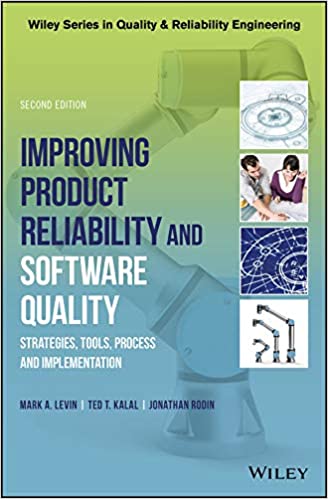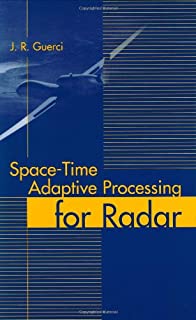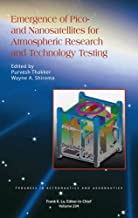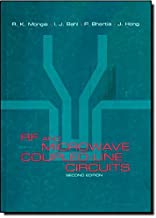Improving Product Reliability and Software Quality: Strategies, Tools, Process and Implementation
Original price was: ₹6,523.40.₹5,218.72Current price is: ₹5,218.72.
ISBN: 9781119179399
Author/Editor: Mark A Levin
Publisher: John Wiley
Year: 2019
1 in stock (can be backordered)
Description
The authoritative guide to the effective design and production of reliable technology products, revised and updated
While most manufacturers have mastered the process of producing quality products, product reliability, software quality and software security has lagged behind. The revised second edition of Improving Product Reliability and Software Quality offers a comprehensive and detailed guide to implementing a hardware reliability and software quality process for technology products. The authors – noted experts in the field – provide useful tools, forms and spreadsheets for executing an effective product reliability and software quality development process and explore proven software quality and product reliability concepts.
Additional information
| Weight | 0.896 kg |
|---|
Product Properties
| Year of Publication | 2019 |
|---|---|
| Table of Contents | About the Authors xix List of Figures xxi List of Tables xxv Series Editor's Foreword xxvii Series Foreword Second Edition xxix Series Foreword First Edition xxxi Foreword First Edition xxxiii Preface Second Edition xxxv Preface First Edition xxxvii Acknowledgments xli Glossary xliii Part I Reliability and Software Quality - It's a Matter of Survival 1 1 The Need for a New Paradigm for Hardware Reliability and Software Quality 3 1.1 Rapidly Shifting Challenges for Hardware Reliability and Software Quality 3 1.2 Gaining Competitive Advantage 5 1.3 Competing in the Next Decade -Winners Will Compete on Reliability 5 1.4 Concurrent Engineering 6 1.5 Reducing the Number of Engineering Change Orders at Product Release 8 1.6 Time-to-Market Advantage 9 1.7 Accelerating Product Development 10 1.8 Identifying and Managing Risks 11 1.9 ICM, a Process to Mitigate Risk 11 1.10 Software Quality Overview 12 References 13 Further Reading 13 2 Barriers to Implementing Hardware Reliability and Software Quality 15 2.1 Lack of Understanding 15 2.2 Internal Barriers 16 2.3 Implementing Change and Change Agents 17 2.4 Building Credibility 19 2.5 Perceived External Barriers 20 2.6 Time to Gain Acceptance 21 2.7 External Barrier 22 2.8 Barriers to Software Process Improvement 23 3 Understanding Why Products Fail 25 3.1 Why Things Fail 25 3.2 Parts Have Improved, Everyone Can Build Quality Products 28 3.3 Hardware Reliability and Software Quality -The New Paradigm 28 3.4 Reliability vs. Quality Escapes 29 3.5 Why Software Quality Improvement Programs Are Unsuccessful 30 Further Reading 31 4 Alternative Approaches to Implementing Reliability 33 4.1 Hiring Consultants for HALT Testing 33 4.2 Outsourcing Reliability Testing 33 4.3 Using Consultants to Develop and Implement a Reliability Program 34 4.4 Hiring Reliability Engineers 34 Part II Unraveling the Mystery 37 5 The Product Life Cycle 39 5.1 Six Phases of the Product Life Cycle 39 5.2 Risk Mitigation 41 5.3 The ICM Process for a Small Company 45 5.4 Design Guidelines 46 5.5 Warranty 46 Further Reading 47 Reliability Process 47 DFM 48 6 Reliability Concepts 49 6.1 The Bathtub Curve 50 6.2 Mean Time between Failure 51 6.3 Warranty Costs 53 6.4 Availability 55 6.5 Reliability Growth 57 6.6 Reliability Demonstration Testing 59 6.7 Maintenance and Availability 62 6.8 Component Derating 69 6.9 Component Uprating 70 Reference 71 Further Reading 72 Reliability Growth 72 Reliability Demonstration 72 Prognostics and Health Management 72 7 FMEA 73 7.1 Benefits of FMEA 73 7.2 Components of FMEA 74 7.3 Preparing for the FMEA 86 7.4 Barriers to the FMEA Process 89 7.5 FMEA Ground Rules 91 7.6 Using Macros to Improve FMEA Efficiency and Effectiveness 92 7.7 Software FMEA 94 7.8 Software Fault Tree Analysis (SFTA) 97 7.9 Process FMEAs 97 7.10 FMMEA 99 8 The Reliability Toolbox 101 8.1 The HALT Process 101 8.2 Highly Accelerated Stress Screening (HASS) 121 8.3 HALT and HASS Test Chambers 127 8.4 Accelerated Reliability Growth (ARG) 128 8.5 Accelerated Early Life Test (ELT) 131 8.6 SPC Tool 132 8.7 FIFO Tool 132 References 134 Further Reading 134 FMEA 134 HALT 135 HASS 136 Quality 136 Burn-in 136 ESS 137 Up Rating 137 9 Software Quality Goals and Metrics 139 9.1 Setting Software Quality Goals 139 9.2 Software Metrics 140 9.3 Lines of Code (LOC) 142 9.4 Defect Density 142 9.5 Defect Models 144 9.6 Defect Run Chart 145 9.7 Escaped Defect Rate 147 9.8 Code Coverage 148 References 149 Further Reading 150 10 Software Quality Analysis Techniques 151 10.1 Root Cause Analysis 151 10.2 The 5 Whys 151 10.3 Cause and Effect Diagrams 152 10.4 Pareto Charts 153 10.5 Defect Prevention, Defect Detection, and Defensive Programming 154 10.6 Effort Estimation 157 Reference 158 Further Reading 158 11 Software Life Cycles 159 11.1 Waterfall 159 11.2 Agile 161 11.3 CMMI 162 11.4 How to Choose a Software Life Cycle 165 Reference 166 Further Reading 166 12 Software Procedures and Techniques 167 12.1 Gathering Requirements 167 12.2 Documenting Requirements 169 12.3 Documentation 172 12.4 Code Comments 173 12.5 Reviews and Inspections 174 12.6 Traceability 179 12.7 Defect Tracking 179 12.8 Software and Hardware Integration 180 References 182 Further Reading 182 13 Why Hardware Reliability and Software Quality Improvement Efforts Fail 183 13.1 Lack of Commitment to the Reliability Process 183 13.2 Inability to Embrace and Mitigate Technologies Risk Issues 185 13.3 Choosing the Wrong People for the Job 186 13.4 Inadequate Funding 186 13.5 Inadequate Resources 191 13.6 MIL-HDBK 217 -Why It Is Obsolete 192 13.7 Finding But Not Fixing Problems 195 13.8 Nondynamic Testing 196 13.9 Vibration Testing Too Difficult to Implement 196 13.10 The Impact of Late Hardware or Late Software Delivery 196 13.11 Supplier Reliability 196 Reference 197 Further Reading 197 14 Supplier Management 199 14.1 Purchasing Interface 199 14.2 Identifying Your Critical Suppliers 200 14.3 Develop a Thorough Supplier Audit Process 200 14.4 Develop Rapid Nonconformance Feedback 201 14.5 Develop a Materials Review Board (MRB) 202 14.6 Counterfeit Parts and Materials 202 Part III Steps to Successful Implementation 205 15 Establishing a Reliability Lab 207 15.1 Staffing for Reliability 207 15.2 The Reliability Lab 208 15.3 Facility Requirements 210 15.4 Liquid Nitrogen Requirements 210 15.5 Air Compressor Requirements 211 15.6 Selecting a Reliability Lab Location 212 15.7 Selecting a Halt Test Chamber 213 Reference 220 16 Hiring and Staffing the Right People 221 16.1 Staffing for Reliability 221 16.2 Staffing for Software Engineers 225 16.3 Choosing the Wrong People for the Job 226 17 Implementing the Reliability Process 229 17.1 Reliability Is Everyone's Job 229 17.2 Formalizing the Reliability Process 230 17.3 Implementing the Reliability Process 231 17.4 Rolling Out the Reliability Process 231 17.5 Developing a Reliability Culture 235 17.6 Setting Reliability Goals 236 17.7 Training 237 17.8 Product Life Cycle Defined 238 17.9 Proactive and Reactive Reliability Activities 241 Further Reading 244 Reliability Process 244 Part IV Reliability and Quality Process for Product Development 245 18 Product Concept Phase 247 18.1 Reliability Activities in the Product Concept Phase 247 18.2 Establish the Reliability Organization 248 18.3 Define the Reliability Process 249 18.4 Define the Product Reliability Requirements 249 18.5 Capture and Apply Lessons Learned 249 18.6 Mitigate Risk 252 19 Design Concept Phase 257 19.1 Reliability Activities in the Design Concept Phase 257 19.2 Set Reliability Requirements and Budgets 259 19.3 Define Reliability Design Guidelines 263 19.4 Revise Risk Mitigation 264 19.5 Schedule Reliability Activities and Capital Budgets 268 19.6 Decide Risk Mitigation Sign-off Day 269 19.7 Reflect on What Worked Well 271 20 Product Design Phase 273 20.1 Product Design Phase 273 20.2 Reliability Estimates 274 20.3 Implementing Risk Mitigation Plans 276 20.4 Design for Reliability Guidelines (DFR) 285 20.5 Design FMEA 289 20.6 Installing a Failure Reporting Analysis and Corrective Action System 290 20.7 HALT Planning 291 20.8 HALT Test Development 292 20.9 Risk Mitigation Meeting 295 Further Reading 296 FMEA 296 HALT 296 21 Design Validation Phase 299 21.1 Design Validation 299 21.2 Using HALT to Precipitate Failures 301 21.3 Proof of Screen (POS) 313 21.4 Highly Accelerated Stress Screen (HASS) 315 21.5 Operate FRACAS 315 21.6 Design FMEA 317 21.7 Closure of Risk Issues 317 Further Reading 318 FMEA 318 Acceleration Methods 318 ESS 318 HALT 319 22 Software Testing and Debugging 321 22.1 Unit Tests 321 22.2 Integration Tests 323 22.3 System Tests 324 22.4 Regression Tests 324 22.5 Security Tests 326 22.6 Guidelines for Creating Test Cases 327 22.7 Test Plans 328 22.8 Defect Isolation Techniques 329 22.9 Instrumentation and Logging 331 Further Reading 334 23 Applying Software Quality Procedures 335 23.1 Using Defect Model to Create Defect Run Chart 336 23.2 Using Defect Run Chart to Know When You Have Achieved the Quality Target 336 23.3 Using Root Cause Analysis on Defects to Improve Organizational Quality Delivery 338 23.4 Continuous Integration and Test 338 Further Reading 339 24 Production Phase 341 24.1 Accelerating Design Maturity 341 24.2 Reliability Growth 346 24.3 Design and Process FMEA 351 Further Reading 355 FMEA 355 Quality 356 Reliability Growth 356 Burn-In 357 HASS 357 25 End-of-Life Phase 359 25.1 Managing Obsolescence 359 25.2 Product Termination 360 25.3 Project Assessment 360 Further Reading 361 26 Field Service 363 26.1 Design for Ease of Access 363 26.2 Identify High Replacement Assemblies (FRUs) 363 26.3 Wearout Replacement 365 26.4 Preemptive Servicing 365 26.5 Servicing Tools 365 26.6 Service Loops 366 26.7 Availability or Repair Time Turnaround 367 26.8 Avoid System Failure Through Redundancy 367 26.9 Random versus Wearout Failures 367 Further Reading 368 Appendix A 369 A.1 Reliability Consultants 369 A.2 Graduate Reliability Engineering Programs and Reliability Certification Programs 372 A.3 Reliability Professional Organizations and Societies 376 A.4 Reliability Training Classes 377 A.5 Environmental Testing Services 379 A.6 HALT Test Chambers 381 A.7 Reliability Websites 382 A.8 Reliability Software 383 A.9 Reliability Seminars and Conferences 384 A.10 Reliability Journals 386 Appendix B 387 B.1 MTBF, FIT, and PPM Conversions 387 B.2 Mean Time Between Failure (MTBF) 387 B.3 Estimating Field Failures 396 B.3.1 Comparing Repairable to Nonrepairable Systems 397 Index 399 |
| Author | Mark A Levin |
| ISBN/ISSN | 9781119179399 |
| Binding | Hardback |
| Edition | 2 |
| Publisher | John Wiley |
You must be logged in to post a review.






Reviews
There are no reviews yet.